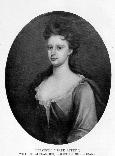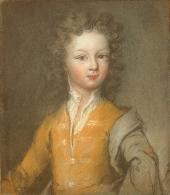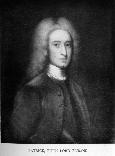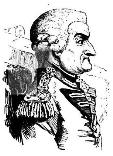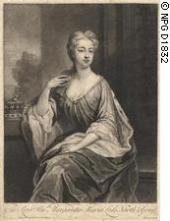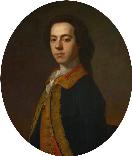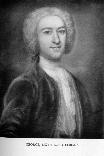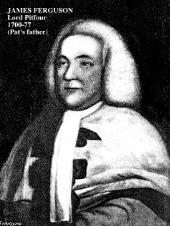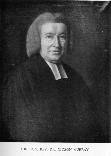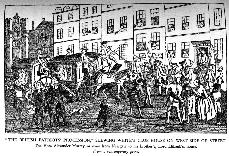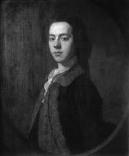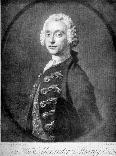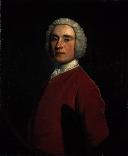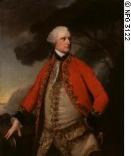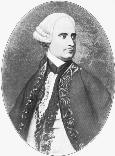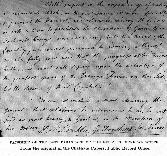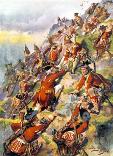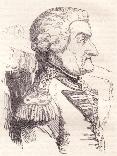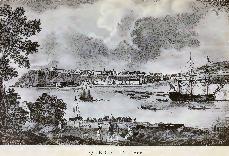See also
- George STIRLING's father: unk STIRLING ( - )
George STIRLING ( - )
1. George STIRLING, son of unk STIRLING ( - ), was a Surgeon; Member of Parliament. He appeared in the census.
Very little is known of this eminent Edinburgh surgeon, except a rather unusual anecdote, showing his sympathies with the the martyred Rev. James Guthrie:
A little before coming out of the tolbooth to proceed to execution, his wife embracing him said, "Now, my heart," her usual way of addressing him, "your time is drawing nigh, and I must take my last farewell of you."?Ay, you must," he answered, "for henceforth I know no man after the flesh." Before being brought out to suffer, a request was made to the authorities by his friends, to allow him to wear his hat on the way to the scaffold, and also that they would not pinion him until he reached the place of execution. Both requests were at first denied; the former absolutely, because, as was alleged, the marquis of Argyle, who had been executed a short while before, had worn his hat, in going to the scaffold; in a manner markedly indicative of defiance and contempt, and which had given much offence. To the latter request, that he might not be pinioned, they gave way so far, on a representation being made that he could not walk without his staff, on account of the rose being in one of his legs, as to allow him so much freedom in his arms as to enable him to make use of that support, but From the story of the demise of the Rev. James Guthrie, comes this anecdote about George Stirling:
.... they would not altogether dispense with that fatal preparation. Having ascended the scaffold, he delivered with a calm and serene countenance an impressive address to those around him; justified all for which he was about to suffer, and recommended all who heard him to adhere firmly to the covenant. After hanging for some time, his head was struck off and placed on the Netherbow Port, where it remained for seven and twenty years, when it was taken down and buried by a Mr Alexander Hamilton at the hazard of his own life. The body, after being beheaded, was carried to the Old Kirk, where it was dressed by a number of ladies who waited its arrival for that purpose; many of whom, besides, dipped their napkins in his blood, that they might preserve them as memorials of so admired a martyr. While these gentlewomen were in the act of discharging this pious duty, a young gentleman suddenly appeared amongst them, and without any explanation, proceeded to pour out a bottle of rich perfume on the dead body. "God bless you, sir, for this labour of love," said one of the ladies, and then without uttering a word, this singular visitor departed. He was, however, afterwards discovered to be a surgeon in Edinburgh named George Stirling.
STIRLING George - Scot
1694.00.00 - 1694.30.03 MD
[Date of Utrecht MD in Leyden volume is 1690]; Thesis `de scorbuto'; MA Edin 1690; Probably the Edinburgh surgeon who became physician FRCP Edin. George Stirling MD of Haddington; Died before 1731; Edinburgh Testaments 1712; [Not inscribed]. 543/292-3; 546/172-3; 860; 882/05&13. Leyden.
George STIRLING had the following children:
| +2 |
Second Generation
2. Elizabeth STIRLING, daughter of George STIRLING, was born before 1683. She appeared in the census. She married Alexander MURRAY in February 1698. She died on 11 November 1756.
Book: "The five sons of Bare Betty" by A.C, Murray:
Elizabeth, who married at 16, displayed form her early teens an independence of character which not infrequently led her into eccentricities, and hse handed on to her sons the traits she herslef possessed of vivacity and original wit in thoought, speech and action. In his "Scotland and Scotsmen" Ramsey tells us an intertesing and amusing anecdote. A somewhat rash Edinburgh minister when conducting "public examinations" referred to Miss Elizabeth as "Betty Stirling". This caused deep offence to the dignity of the young lady: "Mistress Betty" or "Miss Betty", she said in tones of scathing rebuke, was the style of address to which she was accustomed, but certainly not "bare Betty". Needless to say, after this incident, she was always known in Edinburgh and district as "bare Betty".
When a man, who was deeply in love with her, told her that he was ready to lay down his life for her sake, "Oh," she said, "I do not believe you would part with a little joint of your little finger for my whole body." Next day the gentleman returned, and presented her triumphantly with the joint of one of his little fingers. But he was dumbfounded when she gave him a peremptory refusal, "for," said she, "the man who has no mercy on his own flesh will certainly not spare mine."
But despite this mercurial turn "bare Betty had a tender side to her character, and was much beloved by all her family.
Alexander MURRAY 4th Lord Elibank, son of Sir Patrick 3rd MURRAY 3rd Lord Elibank (bef1661-1687) and Anna BURNET ( - ), was born on 9 March 1677. He was a 4th Lord Elibank. He had the title '4th Lord Elibank'. He died on 6 February 1735. He and Elizabeth STIRLING had the following children:
| +3 | |
| +4 | |
| +5 | |
| +6 | |
| +7 | |
| +8 | |
| +9 | |
| +10 | |
| +11 | |
| +12 | |
| +13 | |
| +14 | |
| +15 |
Third Generation
3. Elizabeth MURRAY, daughter of Alexander MURRAY 4th Lord Elibank and Elizabeth STIRLING, was born on 26 August 1701. She was baptised on 27 August 1701. She died on 19 March 1748 in Edinburgh.
She was unmarried.
4. Sir Patrick MURRAY 5th Lord Elibank, son of Alexander MURRAY 4th Lord Elibank and Elizabeth STIRLING, was born on 27 February 1703. He had the title '5th Lord Elibank, Earl of Westminster'. He married Margaretta Maria DE JONGE in 1735. He died on 3 August 1778 in Ballencrieff Castle in Haddingtonshire near Edinburgh.. He married Mary MORTLOCK.
Sir Patrick was a wit, raconteur and friend of Dr. Johnson. He succeeded to the title as 5th Lord, and was also Lieutenant-Colonel in Wynyards Marines. He was a sometime member of the Cocoa Tree Club and The Poker Club.
Besides this, he was a Jacobite who had an involvement with the Elibank plot. "There was to be one more serious conspiracy against King George and his government, the Elibank Plot, which was penetrated and exploded in 1753 by the government led by Henry Pelham, heir to Walpole. The debacle cost the life of the last Jacobite martyr, Dr. Archie Cameron, younger brother to Lochiel, but really by 1753 Prince Charles, despite an expedient conversion to Anglicanism, was not politically viable".
A brilliant man of great knowledge Sir Patrick wrote Essays on Paper Money, Banking, etc. (1755) Thoughts on Money, Circulation, and Paper Currency (1758), Inquiry into the Origin and Consequence of the Public Debts (1758/9), Queries Relating to the Proposed Plan for Altering Entails in Scotland (1765), Letter to Lord Hailes on his Remarks on the History of Scotland (1773) and Considerations on the Present State of the Peerage of Scotland (1774). Alexander Carlyle, in his autobiography, described Lord Elibank as one of the most learned and ingenious noblemen of his time, and as having a mind that embraced the greatest variety of topics and produced the most original remarks.
Details of his connection with James Boswell:
Boswell was with him on 26/11-62 at Lord Eglinton's, describing him as a man of great genius, great knowledge, and much whim. Boswell had a conversation with Lord Elibank in the company of Lord Eglinton, James Macdonald and Thomas Sheridan, mentioned in LJ 291162.
Boswell and Johnson also visited the Lord during their 1773 tour of the Hebrides.
Sir Patrick was a wit, raconteur and friend of Dr. Johnson. He succeeded to the title as 5th Lord, and was also Lieutenant-Colonel in Wynyards Marines. He was a sometime member of the Cocoa Tree Club and The Poker Club. Besides this, he was a Jacobite who had an involvement with the Elibank plot. "There was to be one more serious conspiracy against King George and his government, the Elibank Plot, which was penetrated and exploded in 1753 by the government led by Henry Pelham, heir to Walpole. The debacle cost the life of the last Jacobite martyr, Dr. Archie Cameron, younger brother to Lochiel, but really by 1753 Prince Charles, despite an expedient conversion to Anglicanism, was not politically viable". A brilliant man of great knowledge, Sir Patrick wrote "Essays on Paper Money, Banking, etc. "(1755) "Thoughts on Money, Circulation, and Paper Currency" (1758), "Inquiry into the Origin and Consequence of the Public Debts "(1758/9), "Queries Relating to the Proposed Plan for Altering Entails in Scotland"(1765), "Letter to Lord Hailes on his Remarks on the History of Scotland" (1773) and "Considerations on the Present State of the Peerage of Scotland "(1774). Alexander Carlyle, in his autobiography, described Lord Elibank as one of the most learned and ingenious noblemen of his time, and as having a mind that embraced the greatest variety of topics and produced the most original remarks. He was a good friend of most notable men of letters of the time, including Boswell. In 1773 Boswell and Samuel Johnson visited Sir Patrick during a tour of the Hebrides. Lord Eglinton described him as a man of great genius, great knowledge and much whim.
Boswell was with him on 26/11-62 at Lord Eglinton's, describing him as a man of great genius, great knowledge, and much whim. Boswell had a conversation with Lord Elibank in the company of Lord Eglinton, James Macdonald and Thomas Sheridan, mentioned in LJ 291162.
Boswell and Johnson also visited the Lord during their 1773 tour of the Hebrides.
From the letters of Horace Walpole:
"Lord Cromartie was receiver of the rents of the King's second son in
Scotland, which, it was understood, he should not account for; and by
that means had six-hundred a-year from the Government: Lord Elibank, a very prating, impertinent Jacobite, was bound for him in nine thousand pounds, for which the Duke is determined to sue him".
MURRAY, PATRICK, fifth lord Elibank, a nobleman distinguished by erudition and literary taste, was the eldest son of Alexander, the preceding lord, by Elizabeth, daughter of George Stirling, surgeon in Edinburgh. He was born in February, 1703. For reasons with which we are unacquainted, he studied for the Scottish bar, at which he entered in 1723, but in the same year adopted the military profession, and soon rose to a considerable rank in the army. He was, in 1740, a lieutenant-colonel under lord Cathcart, in the expedition to Carthagena, of which he wrote an account, that remains in manuscript in the library of the Board of Trade. He had now succeeded to the family title, and was distinguished for his wit and general ability. His miscellaneous reading was extensive and we have the authority of Dr Johnson, that it was improved by his own observations of the world. He lived for many years at a curious old house, belonging to the family of North, at Catage in Cambridgeshire; and it has been recently ascertained that he kept up a correspondence with the exiled house of Stuart. In the latter part of his life, he appears to have chiefly resided in Edinburgh, mingling with the distinguished literati of the city, who were his contemporaries, and fully qualified by his talents and knowledge, to adorn even that society.
In 1758, he published at Edinburgh, "Thoughts on Money, Circulation, and Paper Currency;" and an "Inquiry into the Origin and Consequence of the Public Debts" appeared afterwards. In 1765, he issued "Queries relating to the proposed Plan for altering Entails in Scotland," and, in 1773, a "Letter to lord Hailes on his Remarks on the History of Scotland." His lordship’s political life was entirely that of an opposition lord, and, among other subjects which attracted his indignant attention, was the servile condition of his native peerage. In the year 1774, he published a work under the title of "Considerations on the Present State of the Peerage of Scotland," which attracted a considerable degree of attention. "Never," says he "was there so humbling a degradation as what the Scots peers of the first rank and pretensions suffer, by the present mode of their admittance to the house of lords. For the truth of this, one needs but to appeal to their own feelings, or to the common estimation of mankind. A Scots peer of the first rank is considered as an instrument singled out, and posted in the house of lords by the appointment of the minister at the time, for the end of supporting his measures, whatever they are or may be; and who, in case of failure, must expect to be turned out at the expiration of his term of seven years. He is supposed to be composed of such pliant materials, that in the event of a change of administration, the next minister makes no doubt of finding him equally obsequious, and ready to renounce his former connexions." When Dr Johnson visited Scotland in 1773, lord Elibank addressed to him a courteous letter, which is to be found in Boswell’s Tour to the Hebrides, where are also the records of various conversations in which both men flourished. The English philosopher declared that he never met his lordship, without going away a " wiser man." Lord Elibank in early life married the dowager lady North and Grey, who was by birth a Dutch-woman, and of illustrious extraction. He died, without issue, August 3, 1778, in the seventy-sixth year of his age.
Dr. Johnson quote: "Johnson characterized three orders of persons, in General Oglethorpe, Lord Elibank, and Burnet, Bishop of Salisbury. Oglethorpe never completed what he had to say; Elibank had nothing conclusive in his talk ; and Burnet took no pains to be right.".
Mary MORTLOCK and Patrick MURRAY had the following children:
| 16 | Ann MURRAY ( -1843). Ann was born in Guildford, Surrey. She died on 6 May 1843 in Florence. |
Lady Margaretta Maria DE JONGE, daughter of Cornelis DE JONGE VAN ELLEMEET ( - ), had the title 'Lady Elibank'. She died on 6 June 1762. She and Patrick MURRAY had the following children:
| 17 | Maria Margaret MURRAY (1765?-1855). Maria was born in 1765 (calculated). She died on 15 January 1855 in Florence. |
5. Alexander MURRAY, son of Alexander MURRAY 4th Lord Elibank and Elizabeth STIRLING, was born on 23 July 1704. He died in 1705.
6. Admiral George MURRAY 6th Lord Elibank, son of Alexander MURRAY 4th Lord Elibank and Elizabeth STIRLING, was born on 14 May 1706 in Aberlady. He was an Admiral in the Navy. He had the title 'Admiral, 6th Lord Elibank'. He married Isabella MCKENZIE on 8 January 1760. He died on [Julian] 12 November 1785 in Ballencrieff.
George had a distinguished career in the Royal Navy serving under Admiral Anson, whom he accompanied in part of his famous voyage around the world, although some controversy surrounded the fact of Murray's separation from Anson's fleet in very difficult and dangerous circumstances in waters around Cape Horn, although Murray's position has been fully explained and his conduct completely exonerated by the Hon. Arthur C. Murray in his book "An Episode in the Spanish War". Geroge Murray commanded various ships including HMS Tryal,Wager,Pearl, Hampshire,and Revenge. He left the navy in 1756 and suceeded his brother Patrick as 6th Lord Elibank in 1788.
Pilot Darrell’s Square is named for Pilot James Darrell who was one of three slaves chosen to work with
Lieutenant Thomas Hurd when he surveyed the channels and harbours around Bermuda in the 1790s. In May
1795, James Darrell piloted Admiral George Murray’s ship, the 74-gun HMS Resolution, through the Narrows
Channel into the newly charted Murray’s Anhorage. Admiral Murray was so impressed with James Darrell’s
skill that he recommended to Governor James Craufurd that Pilot Darrell be granted his freedom. James
Darrell was owned by Frances Darrell of St. George’s, and when the latter died, James Darrell was purchased
by the Governor who gave him his freedom in accordance with Admiral Murray’s request. Pilot James Darrell
received his freedom in March 1796 at 47 years of age and became the first black man to purchase a house
in Bermuda. The house, which was renovated in 1992, still stands at Pilot Darrell’s Square and is owned by
James Darrell’s descendents. From Pilot Darrell’s Square there is a superb view of the bell tower at the
western end of St. Peter’s Church. This view is framed by Taylor House, one of the prettiest and most
photographed houses in St. George’s and by a massive chimney which is one of seven beautiful chimneys at
Stewart Hall.
Rear Admiral George Murray
In May 1794, after war was again declared in 1793 between Britain and France, more British naval vessels were needed in the western Atlantic to deter French privateers. Rear Admiral George Murray sailed from Plymouth, England, with a Royal Navy squadron. It reinforced the few frigates based at Halifax under Commodore Rupert George. Cruising that summer off the Chesapeake Bay and the Carolinas in search of French vessels, Murray needed a base for his patrols during the winter.
Lieutenant Thomas Hurd RN, A marine surveyor, had charted the waters of Canada's Atlantic and Gulf of St. Lawrence. He was sent to Bermuda, to sound existing channels through the reefs and find new ones prior to the building of a British naval base in Bermuda. He began his surveys in the late 1780s and completed them in 1792.
In early October that year, on his flagship HMS Resolution off the American coast, Murray was told of Lieutenant Hurd's surveys and findings in Bermuda and dispatched the 32 gun frigate Cleopatra, under Captain Penrose, to Bermuda to bring back a report and charts from Hurd. What they revealed impressed Murray so much that he called at Bermuda himself before his return to Halifax in the spring. Murray sent Penrose and the Cleopatra back to Bermuda in February, 1795, to pick up French prize crews, during which time Penrose made his own glowing report of the facilities Bermuda could offer. Murray ordered Penrose to rendezvous with him at Bermuda in May, 1795 and was so further impressed with what he saw personally, as well as in the reports of Captains Penrose and Pender (of HMS Resolution) and Lieutenant Hurd, that he enclosed them with his own report to the Admiralty dated May 27, 1795.
Isabella MCKENZIE, daughter of George MCKENZIE ( - ), died on [Julian] 28 December 1801 in Ross. She and George MURRAY had the following children:
| 18 | |
| 19 |
7. Anne MURRAY, daughter of Alexander MURRAY 4th Lord Elibank and Elizabeth STIRLING, was born on 20 September 1708. She married James FERGUSON on 3 February 1733 in Aberlady. She died on 2 January 1793.
From a letter to her brother, General Jon. James Murray:
"I have three girls, none of whom have any claims to the beauties of the body. Annie whom you visited in the Small Pox is of a low stature, and pretty much pitted without having her features altered by them. Betty is taller than I am, genteel enough and when in here good looks is thought by strangers to have a resemblance to my Sister Jannie; Jeanie who is of Annies size is in point of looks middling, but for a soul and genious I'll sett her loose with any she that ever stept in petticoats, she had cost me more trouble than all the rest, for her genious bewitched me, and some times got the better of my reason. But now, after Hunting, Riding, Shooting and Latin, I have got her brought to a moderate use of her needle, which with a little musick, bowling and chess, which I indulge her in, makes her turn out a good decent girl of sixteen. As to her dancing, its the Horn Pipe she excells in; but I must not conclude without assuring you that they are modest, virtuous girls, uncapable of lying of falsehood, and just the reverse of some others that you'll remember.".
James FERGUSON of Pitfour, son of James FERGUSON (1672-1734) and Anne STUART of Crichie (1669-1731), was born in 1700. He had the title '2nd of Pitfour'. He died on 25 June 1777 in Woolmet. He and Anne MURRAY had the following children:
| 20 | James FERGUSON (1735-1820). James was born in 1735. He had the title '3rd of Pitfour'. He was an Advocate, MP. He died in 1820. |
| 21 | |
| 22 | Betty FERGUSON ( -1810). Betty died in 1810. |
| 23 | Patrick FERGUSON (1744-1777). Patrick was born in 1744 in Edinburgh. He died in 1777 in Pennsylvania. |
| 24 | Jeanie FERGUSON (1746-1821). Jeanie was born in 1746. She died in 1821. |
| 25 | George FERGUSON (1748-1820). George was born in 1748. He had the title 'Fourth of Pitfour'. He died in 1820. |
8. Revd. Gideon MURRAY, son of Alexander MURRAY 4th Lord Elibank and Elizabeth STIRLING, was born on 5 February 1710 in Ballencrieff. He was a Priest. He married Elizabeth MONTOLIEU DE ST. HYPPOLITE on [Julian] 30 June 1746 in London. He died on [Julian] 21 June 1776 in Wandsworth.
Appointed Chaplain-General to the Army, and Prebendary of the 3rd stall in Durham Cathedral. Was present with George II at the battle of Dettingen in 1743. Chaplain of 43rd (afterwards 42nd) Highlanders.
Elizabeth MONTOLIEU DE ST. HYPPOLITE, daughter of Sieur David Montolieu de St. HYPPOLITE ( - ), died on [Julian] 21 November 1677. She and Gideon MURRAY had the following children:
| 26 | Alexander MURRAY (1747-1864). Alexander was born on [Julian] 24 April 1747. He was a Soldier, member of Parliament. He had the title '7th Baron Elibank'. He married Mary Clara MONTOLIEU on 20 April 1776. He married Catherine STEUART in 1804. He died on [Julian] 24 September 1864 in Portobello. |
| 27 | David MURRAY (1748-1794). David was born on [Julian] 10 May 1748. He was a MP for Peebles and New Radnor in 1790. He married Elizabeth HARLEY on 8 October 1783. He died on [Julian] 8 May 1794 in London. |
9. John MURRAY, son of Alexander MURRAY 4th Lord Elibank and Elizabeth STIRLING, was born on 14 September 1711. He died on 31 December 1711.
10. Alexander MURRAY, son of Alexander MURRAY 4th Lord Elibank and Elizabeth STIRLING, was born on 9 December 1712 in Ballencrieff. He was christened on 9 December 1712 in Aberlady. He was a Politician. He had the title 'Jacobite Earl of Westminster'. He died on 27 February 1778 in Taplow, Bucks.
Alexander Murray developed into a well-known and vehement Jacobite, and refused to kneel to the House of Commons.
"Mr Alexander Murray was so enthusiastic a Jacobite as to propose leading an insurrection even after the close of all the just hopes of the house of Stuart in 1746. He was confined for more than a year subsequent to May 1750, by order of the house of commons, for violent interference with a Westminster election; and, as he refused to express contrition on his knees, according to the order of the house, he might have been confined for a much longer period, if the prorogation of parliament had not brought about his enlargement".
The Elibank Plot and Alexander Murray:
... Charles Edward [the Young Pretender] did not give up. He tried to persuade Louis XV to go to war again. Lochiel urged for another invasion in 1747 a year before his death in Flanders. There were other Jacobite plots later but none succeeded. The last Jacobite to be executed was Dr Archibald Cameron, Lochiel's brother, after Alexander Murray's Elibank Plot to abduct or assassinate the whole royal family was exposed by young MacDonell of Glengarry (the spy code named 'Pickle') in 1753. When George III succeeded his grandfather as King in 1760 he was accepted in a way his predecessors had not been. Unlike them - and unlike Charles Edward - he had even been born in Britain. The Old Pretender, James Francis, died in 1766. Charles Edward started calling himself Charles III but this meant little. He died in 1788 a disappointed drunkard. His younger brother Henry became a Cardinal. As Henry IX he died in 1807, recognising George III and his descendants as the lawful kings.
Alexander was an ensign in the 26th Foot (Cameronians) until taking up politics.
After refusal to kneel in the House of Commons was committed to Newgate Prison and was released by order of the Sherrifs of London when Parliament was prorogues.
He eventually went into exile in France and there was involved in the "Elibank Plot" to restore the Stewarts to the Throne. In 1759 was created Earl of Westminster by the Pretender (Chevalier de St. George, James Eighth and Third). He was recalled from exile under the King's Privy Seal in 1771 and died, unmarried, at Taplow in 1778.
11. Mary MURRAY, daughter of Alexander MURRAY 4th Lord Elibank and Elizabeth STIRLING, was born on 4 September 1714. She was baptised on 5 September 1714. She died on 18 June 1772.
She died unmarried.
12. Helen MURRAY, daughter of Alexander MURRAY 4th Lord Elibank and Elizabeth STIRLING, was born on 19 January 1716. She was baptised on 24 January 1716. She married John (James) STEWART on 12 September 1761 in Edinburgh. She died on 28 December 1809 in Ormistoun.
13. General Sir James Patrick 1 MURRAY Governor of Canada, Warden of the Cinque Ports, Governor of Hull, son of Alexander MURRAY 4th Lord Elibank and Elizabeth STIRLING, was born on [Julian] 21 January 1721 in Ballencrieff. He was a Governor General of Canada, General in the Army, Governor of Minorca, Governor of Hull, Warden of the Cinque Ports. He married Cordelia COLLIER in 1748 in London. He married Ann WHITHAM on 14 March 1780 in Minorca. He died on 18 June 1794 in Beauport, Hastings, Sussex.
James Murray joined the British army in 1739/40 and served in the West Indies and Europe. Sent to North America in 1757 as a lieutenant colonel during the Seven Years¡¯ War, he commanded a brigade in 1758 during the successful British siege of Louisbourg, in what is now Nova Scotia, under Jeffery Amherst. He was one of General James Wolfe¡¯s three brigadiers in the British expedition against Quebec in 1759. After the British captured the city, Murray was made its military governor. When the French capitulated in 1760, he became military governor of Quebec district; he became the first civil governor of Quebec after its formal cession to Great Britain in 1763, later becoming the first British Governor of Canada. Murray opposed repressive measures against French Canadians, and his conciliatory policy led to charges against him of partiality. Although exonerated, he left his post in 1768 and was appointed governor of Minorca in 1774. He surrendered to French and Spanish troops there in 1782, for which he underwent a court of inquiry in England; after being acquitted, he was made lieutenant general (1772) and later a full general (1783).
Murray was the son of Alexander, 4th Earl Elibank, and the nephew of Patrick and Alexander, two perpetrators of the infamous Elibank plot, which attempted to kidnap the Royal Family and put the Young Pretender on the throne. James, like others in his family, had a strong rebellious streak, and against the wishes of his father, wished to join the army. After repeated refusals by his father James, aged 15, ran away from the family home accompanied by the son of one of his father's gardeners. Lady O'Donnell, James' granddaughter, related: "They concealed themselves for a day in Edinburgh and then embarked at Leith in a fishing smack. After many adventures, they arrived in Holland. James Murray enlisted in the "Scottish Dutch", a regiment composed of Scotchmen in the service of the Stadtholder. Here he remained for two or three years. He used to say in after years that he had been every rank of the army except Drummer, adding "I never was a drummer". One day a Scots nobleman (I think it was Lord Arbuthnot) coming out of the palace of the Hague was much struck by the appearance of a young soldier on duty, who looked fixedly at him: "I think I have seen you before now - you are like the Hon. James Murray who ran away from home". "Yes", answered the soldier, "I am James Murray, but I will never go home till they let me be a soldier". The nobleman made enquiries, heard the highest character of the young soldier, returned at once to Scotland, and induced Lord Elibank gladly to obtain a commission for young James in the British army".
Cordelia COLLIER (known as 'Janet') died on [Julian] 26 June 1779 in Beauport.
Ann WHITHAM, daughter of Colonel Abraham WHITHAM ( -bef1797) and Mary UNK (1724?-1797), was born in 1761 (estimated) in Minorca. She died on 2 August 1824 in Berkley, Sussex. She and James Patrick 1 MURRAY had the following children:
| 28 | Cordelia MURRAY (1781-1849). Cordelia was born on 16 March 1781 in Mahon, Minorca. She married Henry HODGES on 25 April 1803 in Ore. She died on 1 May 1849. |
| 29 | James Patrick 2 MURRAY (1782-1834). James was born on 21 January 1782 in Leghorn. He was a Major-General in the Army. He married Elizabeth RUSHWORTH on 31 January 1803 in Freshwater, Isle of Wight. He died on 5 December 1834 in Killenure House, near Athlone. |
| 30 | Elizabeth Mary MURRAY (1783-1785). Elizabeth was born on 8 November 1783 in Beauport. She died on 8 April 1785 in Beauport. |
| 31 | Wilhelmina MURRAY (1787-1866). Wilhelmina was born on 14 January 1787 in Beauport. She married James DOUGLAS on 18 May 1813. She died on 25 February 1866. |
| 32 | Anne Harriet MURRAY (1788-1850). Anne was born on 10 August 1788 in Beauport. She died on 13 November 1850. |
| 33 | George MURRAY (1794-1794). George was born on 1 February 1794. He died in February 1794. |
14. Barbara MURRAY, daughter of Alexander MURRAY 4th Lord Elibank and Elizabeth STIRLING, married James JOHNSTONE on 1 September 1719. She died on 15 March 1773.
Sir James JOHNSTONE of Westerhall, Baronet had the title 'Sir'. He died on 13 December 1772 in Westerhall. He and Barbara MURRAY had the following children:
| 34 | Barbara JOHNSTONE ( -1765). Barbara was born. She died on 21 October 1765. |
| 35 | William JOHNSTONE ( - ). William had the title 'Fifth baronet'. |
| 36 | Margaret JOHNSTONE (1724-1757). Margaret was born on 30 October 1724. She died in 1757. |
15. Janet MURRAY, daughter of Alexander MURRAY 4th Lord Elibank and Elizabeth STIRLING, was born on 13 July 1723. She was baptised on 19 July 1723. She married Robert MURRAY on 22 June 1750.
Robert MURRAY and Janet MURRAY had the following children:
| 37 | James MURRAY PULTENEY (1755-1811). James was born in 1755. He had the title '7th Baronet'. He married Henrietta Laura JOHNSTONE on 24 July 1794 in Bath House, London. He died on 26 April 1811 in Buckenham, Norfolk. |
| 38 | Elizabeth MURRAY ( -1785). Elizabeth died on 30 June 1785. |
